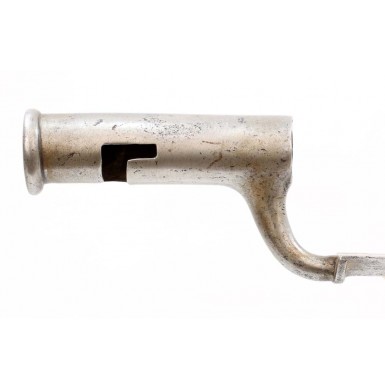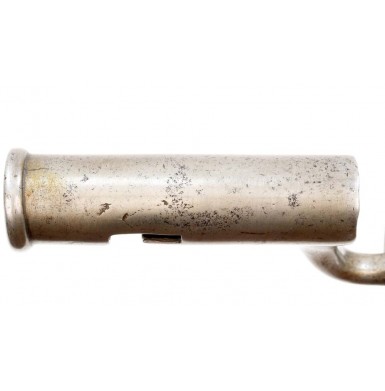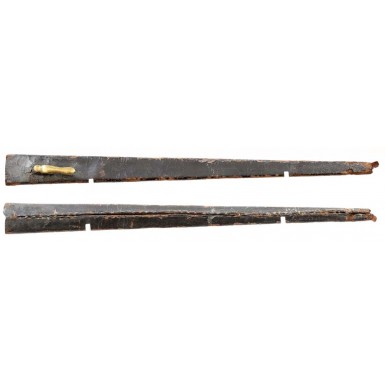British Land Pattern Brown Bess Bayonet c1750s
- Product Code: EWB-2175-SOLD
- Availability: Out Of Stock
-
$1.00
The Land Pattern Socket Bayonet was the first somewhat standardized socket bayonet utilized by the British military. Prior to the adoption of this pattern, many of the bayonets in service were procured at the whim of the Colonel who raised and equipped the regiment, leaving lots of leeway in the quality and specifications of the bayonet. The British Board of Ordnance did not uniformly supply socket bayonets to the infantry until circa 1740, although they did contract for and issue some bayonets prior to that point in time. As a result, great variation in British bayonets is noted prior to that time. These first “standardized” Land Pattern socket bayonets were based upon “hollow triangular blade” socket bayonets that first appear in regimental Colonels procurements circa 1715. Surviving documentation from the Board of Ordnance is almost non-existent for that period, but it is known that two “patterns’ of socket bayonets were adopted, one in 1728 and another in 1768. No doubt additional pattern changes (even if minor) occurred between these two official patterns. For a detailed discourse on the socket bayonet as used on the Brown Bess Muskets, I highly recommend Erik Goldstein’s The Socket Bayonet in the British Army 1687-1783. Research by Goldstein and English bayonet researcher Graham Priest have established a series of features that allow us to classify the Bess bayonets chronologically, based upon their physical characteristics. The most readily identifiable feature of the earliest Land Pattern socket bayonets is the pronounced shield shaped juncture between the shank and the socket. According to their research this was really a decorative feature, not unlike the “Beaver Tail” relief carved apron around the breech plug tang of Brown Bess muskets, and the relief carving that appears around the side plate and lock areas of early Brown Bess pattern muskets. It has been established that this very distinctive decoration disappears from the bayonets circa 1750, so the presence of this feature allows a Bess bayonet to be reliably dated to 1730-1750. After that date the obvious “shield” is no longer present at the joint between the shank and socket, and in some cases it was even removed during refurbishment, changing the “old pattern” bayonet to the “new pattern”. In most other ways the bayonet remained essentially the same as the earlier variant of the first Land Pattern bayonet. Research into the markings found on Land Pattern bayonets by Mr. Goldstein reveals that the (CROWN) / 5 inspection stamp, believed to be the mark of Board of Ordnance viewer (inspector) George Markby, is found on both the earlier “shield shank” bayonets as well as the early production examples of the newer “removed shield” or “shield-less’ bayonets. Because a small collection of regimentally marked Brown Bess muskets from the early 1750s exist in Colonial Williamsburg, along with their original socket bayonets (that are correctly numbered to the guns), Mr. Goldstein has been able to postulate that the (CROWN) / 5 inspection mark was utilized circa 1740-1760. Thus, by examining any Land Pattern socket bayonet with this inspection mark and further analyzing its attributes it is reasonable to estimate the period when it was produced within a fairly narrow window. Additional marks can also help to determine the period from which the bayonet originated. Similar pattern changes allow the astute observer to make reasonable estimates regarding the period during which any accompanying scabbard may have been produced as well.
Offered here is a VERY GOOD condition Land Pattern Bayonet that dates to the period of the “shield-less’ or “removed shield” bayonets circa 1750-1760. The bayonet has two important identifying marks on the ricasso that allow us to make this determination. The first is a worn and only partially legible (CROWN) / 5 inspection mark at the joint between the blade and neck. As noted above this mark allows us to place the bayonet in the period of 1740 to 1760, and as it does not have a “shield” shank, it is most likely from the latter half of that period. The second mark is a Dagger, which is a London cutler’s mark. The use of such marks that had been so common on plug bayonets during the latter portion of the 1600s and the earliest socket bayonets during the first half of the 1700s dropped off precipitously in the latter portion of the 18th century, being replaced by the names of the contractors providing the bayonets to the Board of Ordnance. The bayonet also has three additional physical characteristics that place it in the circa 1750s time frame. As noted above, the bayonet has no “shield” shank at the socket to neck joint. The reinforcement ring around the rear of the socket is small when comparted to India Pattern bayonets that supersede the Land Pattern Bayonet circa 1800. Additionally, the shoulder at the bottom rear of the blade where it meets the shank (or neck) is narrow when compared to earlier or later production “Bess’ bayonets. Taken together, these two blade marks, the physical characteristics noted above and the dimensional information provided below clearly identify this bayonet as circa 1750-1760. The bayonet also bears two marks on the rear edge of the reinforcing ring. The first is a lightly field Broad Arrow mark, indicating Crown ownership, and the second is a set of file slash mating marks that originally mated it to the musket to which it had been fit, prior to delivery to the Board of Ordnance.
The bayonet remains in about VERY GOOD overall condition and is reasonably well marked. The bayonet has an overall length of about 21 ““ with a 17 ““ long blade that is about 1 ““ wide at the widest point. The socket is 4” in length with a muzzle to stud distance of 2” and a muzzle diameter of 23mm (about .90”). A very evident, wavy weld line is present in the blade, angling from about 2 ““ from the shank to 4 ““ from it, where the iron socket and rear portion of the blade were hammer welded to the front portion of the blade, which is made of steel. The bayonet has a mostly dull pewter patina, with mottled patches of darker surface oxidation and discoloration scattered along its length. The blade shows patches of light to moderate pitting scattered along its length, both top and bottom. There are areas that remain mostly smooth as well, but at least half of the blade shows pitting that ranges from light pinpricking to fairly moderate in depth. There is a small nick along the upper left side of the blade, about 3 ““ from the tip, and the very tip itself appears to be lightly nicked along the right leading edge. The socket is smoother, with some moderate pinpricking and light pitting on the left side and significantly less on the right side. The socket appears to have been lightly cleaned at some point and the entire bayonet was likely cleaned some time during the last few decades. The scabbard retains 15 ““ of the leather body, but is missing the very end of the body as well as the brass drag. The brass frog hook is about 1 ““ in length and has the prominent upper lobe typical of post-1750 manufacture. The scabbards made prior to 1750 tend to not have the upper lobe on the hook. The scabbard body retains none of the stitching along its back seam, but retains its shape well and shows only minimal gapping with the stitching missing. The scabbard body retains much of its original surface finish, but it has flaked with age and probably only retains about 60% of that original finish now. The scabbard does not have the Crowned/GR mark typical of scabbards produced circa 1770-1780, and based upon examples provided in Erik Goldstein’s book is probably from the same period as the bayonet.
Overall this is a nice, solid example of a French & Indian War era British Land Pattern Socket Bayonet complete with the majority of its very scarce original scabbard. These pre-Revolutionary War era British socket bayonets are extremely desirable and sought after by collectors, and finding one with most of its original scabbard is a real bonus. This will be a wonderful addition to your display of British arms from the period of the French & Indian War or the American Revolution and will certainly display well with your Brown Bess and other arms in that collection.
SOLD














